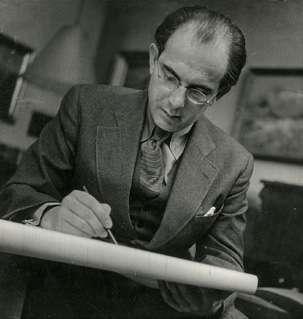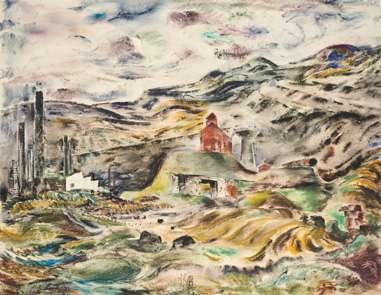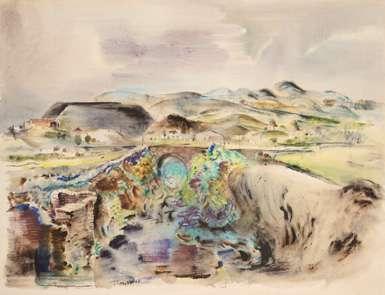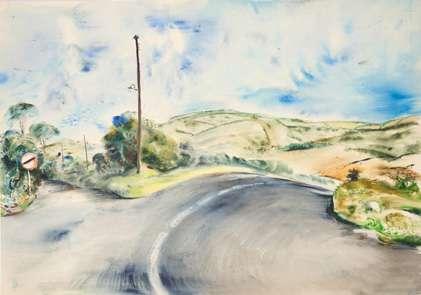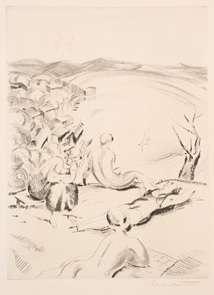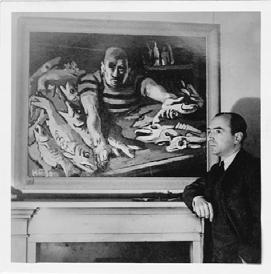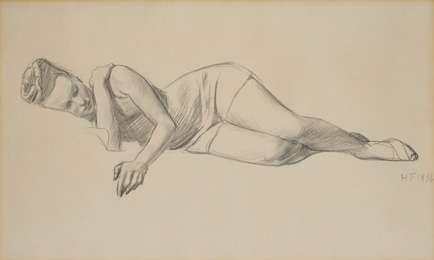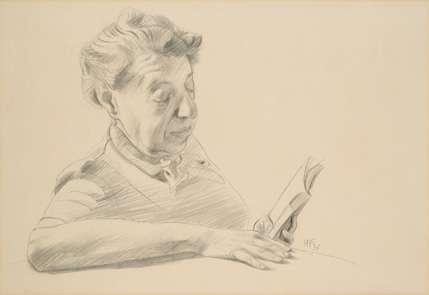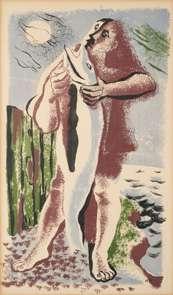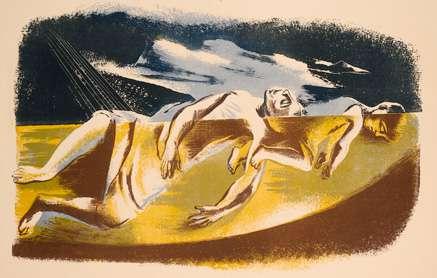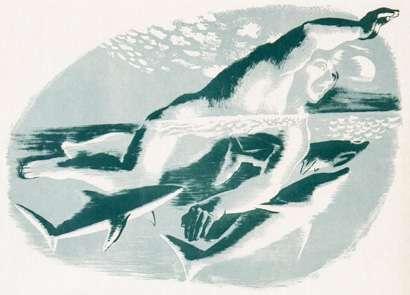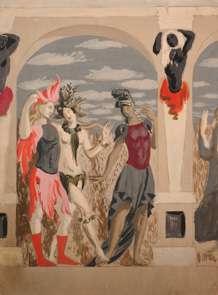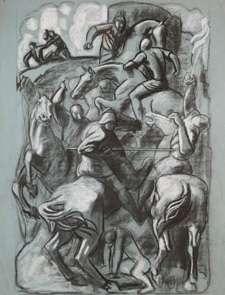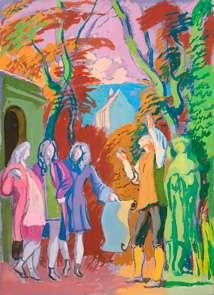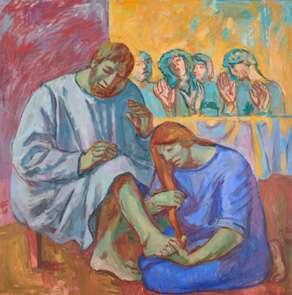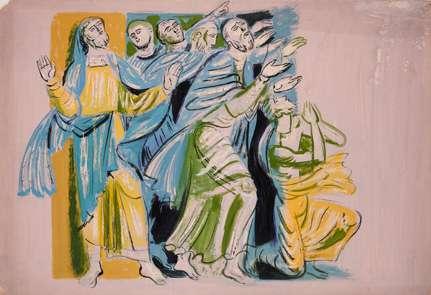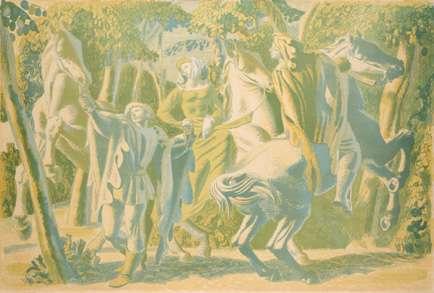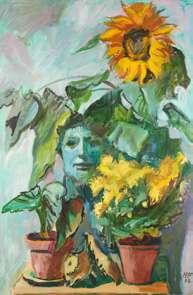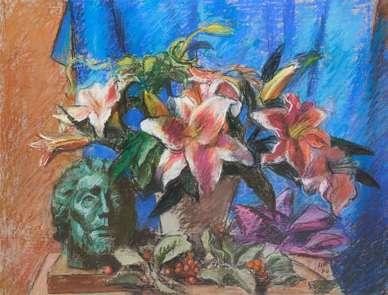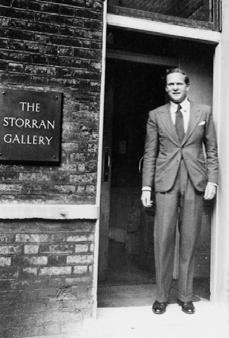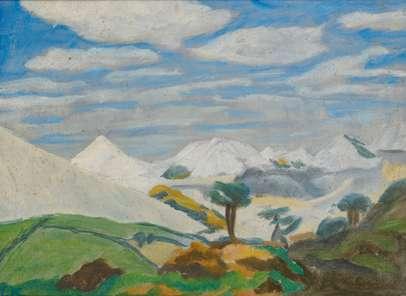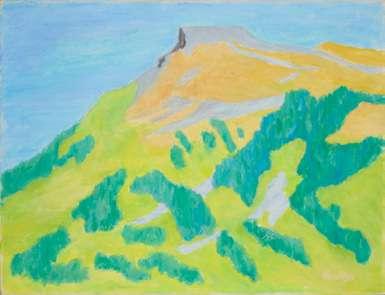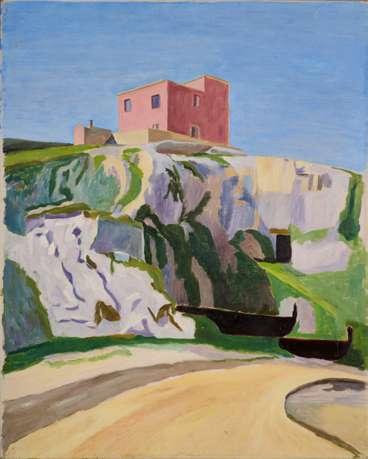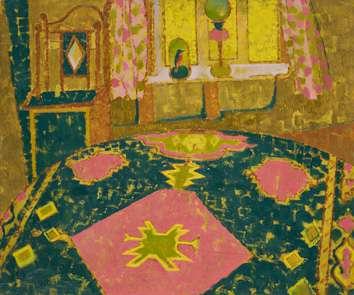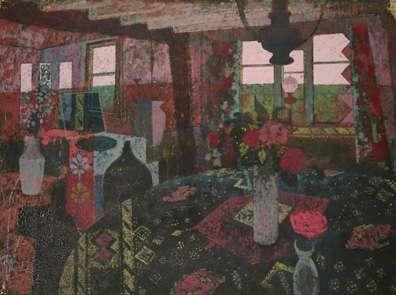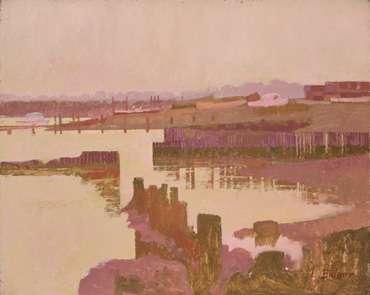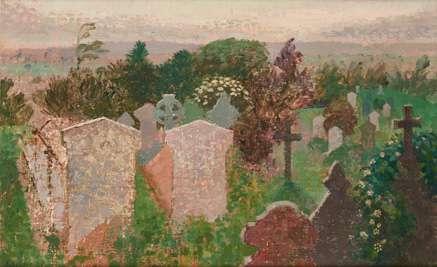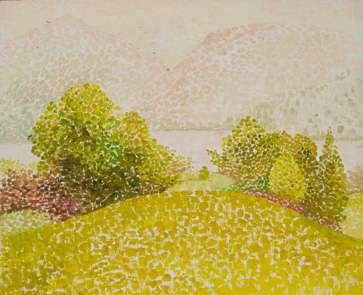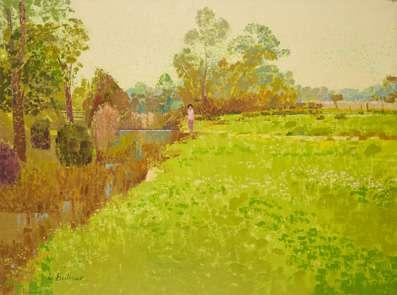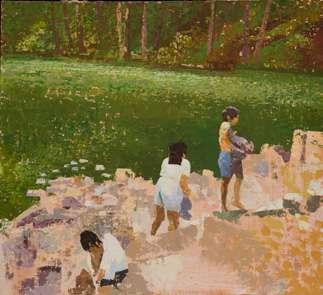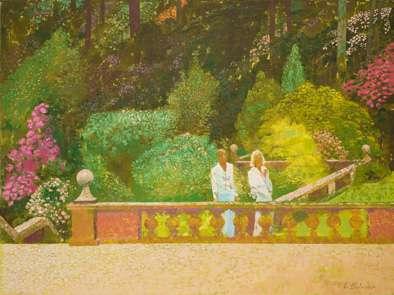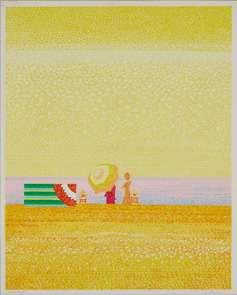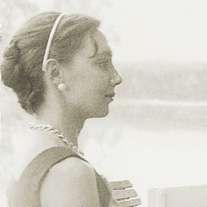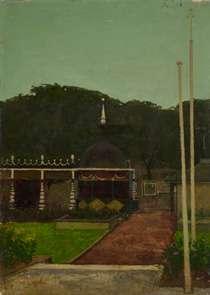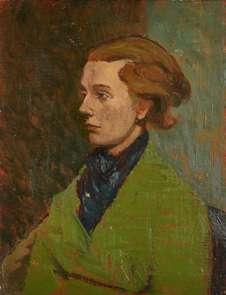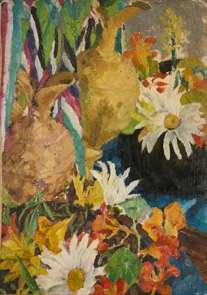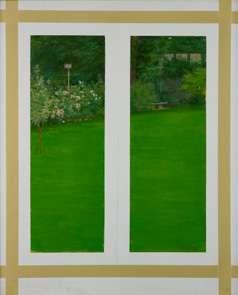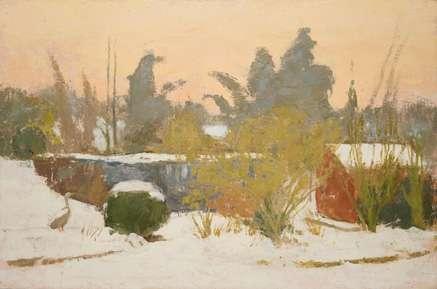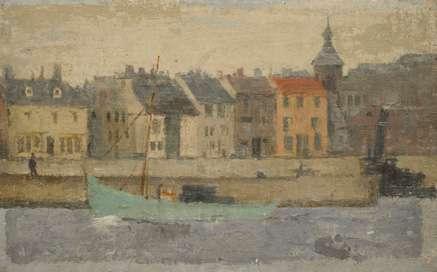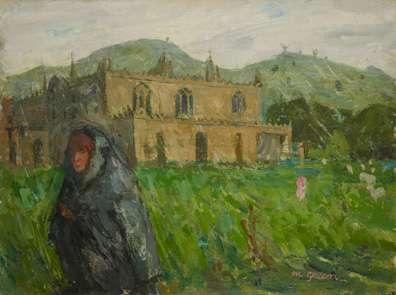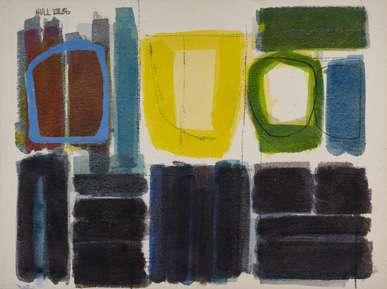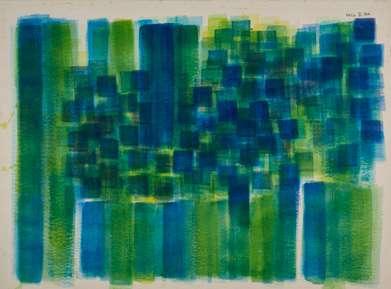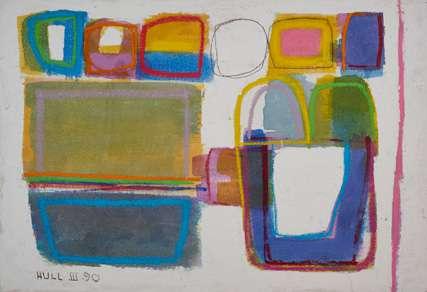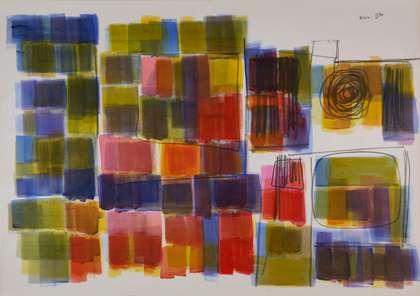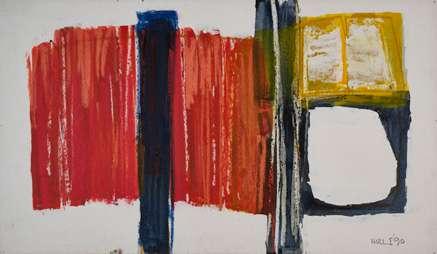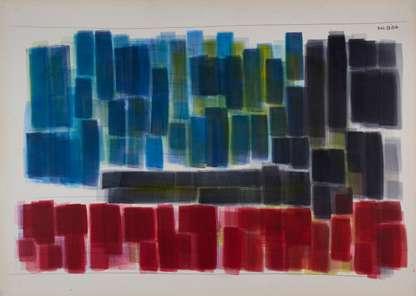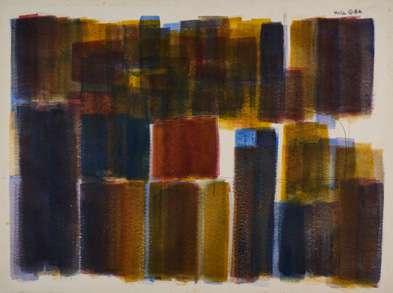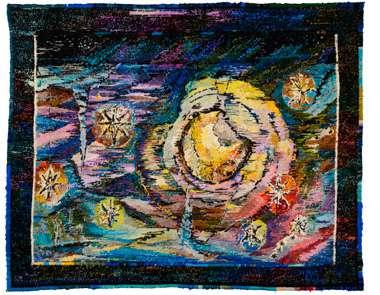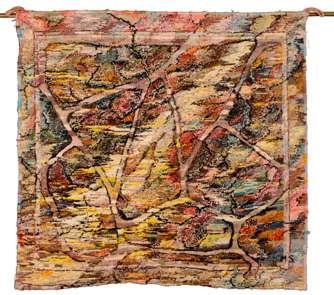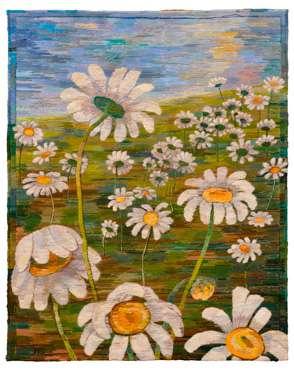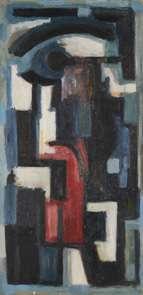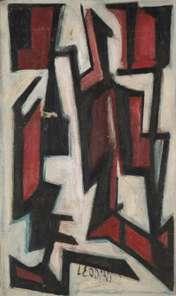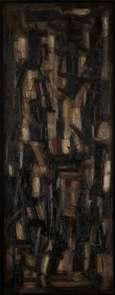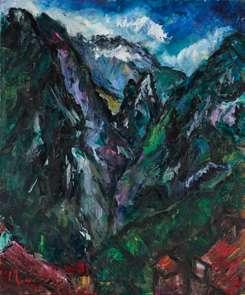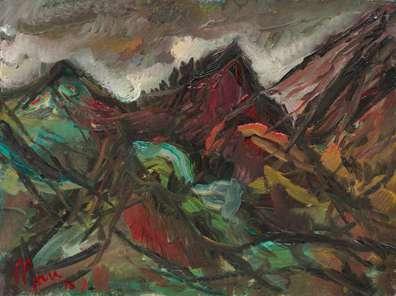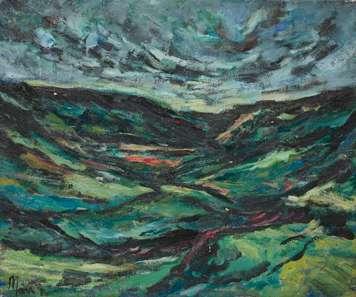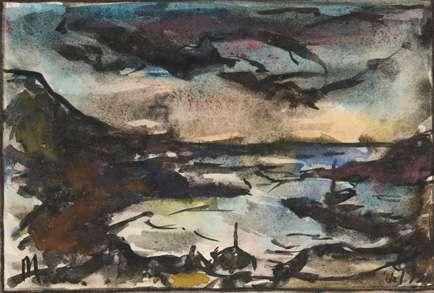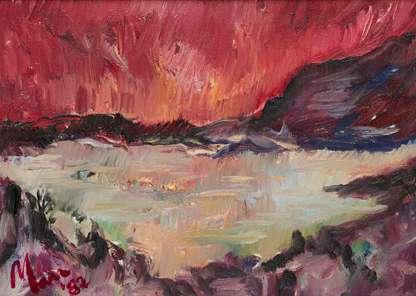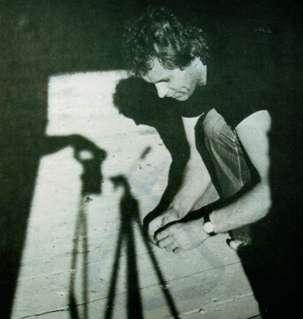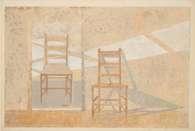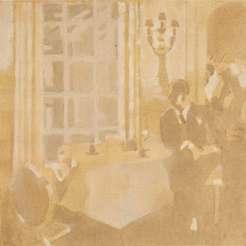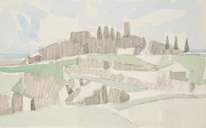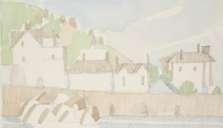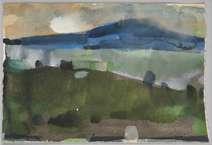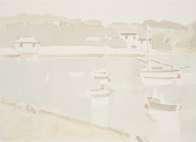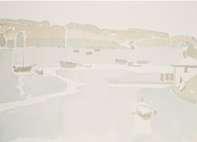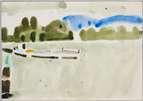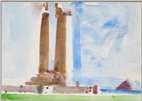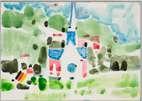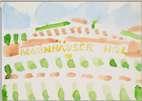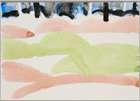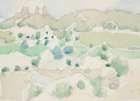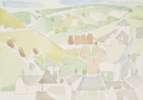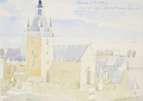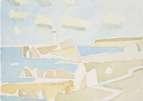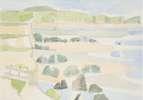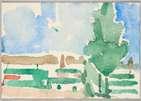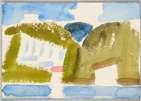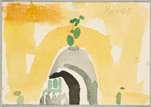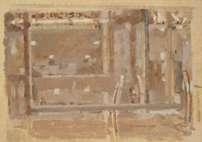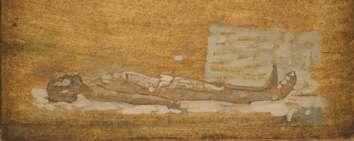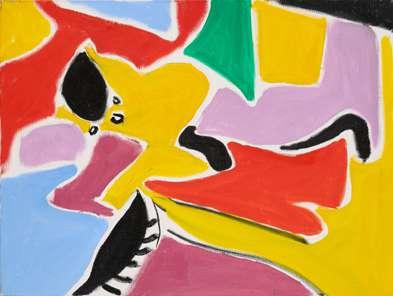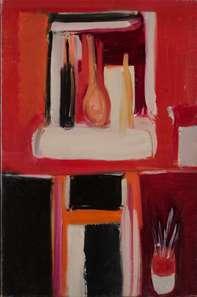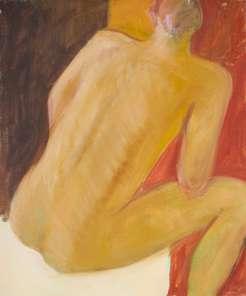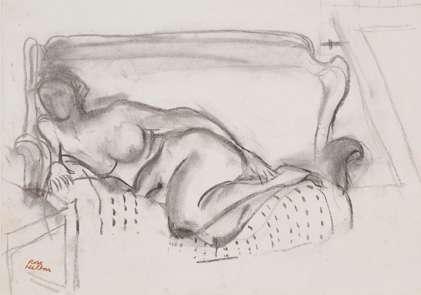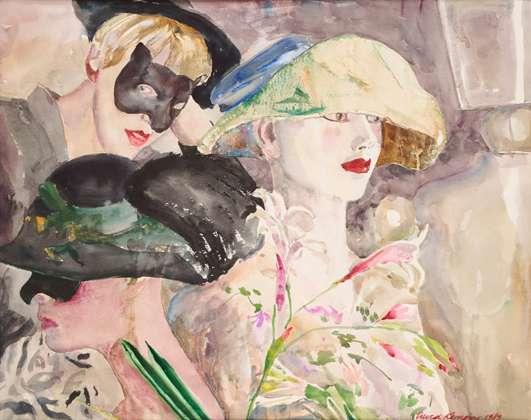EARDL EY KNOLLYS
GEORGE MAYER-MARTON
HANS FEIBUSCH
JAMES HULL
LEO DAVY
LESLIE MARR
LIONEL BULMER
MARGARET GREEN
MICHAEL UPTON
MIRIAM SA CKS
ROSE HILTON FROM THE STUDIO:
WORKS FROM ELEVEN ARTISTS’ ESTATES
WEDNESDAY 12TH MARCH 2025
INDEX:
BULMER, L 40-55
DAVY, L 88-95
FEIBUSCH, H 9-32
GREEN, M 56-67
HILTON, R 124-131
HULL, J 68-79
KNOLLYS, E 33-39
MARR, L 96-107
MAYER-MARTON, G 1-8
SACKS, M 80-87
UPTON, M 108-123
TO BE SOLD BY AUCTION: 25 Blythe Road, London W14 0PD
AUCTION: Wednesday 12th March 2025, 12pm, precisely
PUBLIC EXHIBITION: Sunday 9th March, 12pm to 4pm Monday 10th March, 10am to 8pm (Drinks 5-8pm) Tuesday 11th March, 10am to 5pm
SALE NUMBER OA0155
ENQUIRIES:
Adrian Biddell, Head of Sale adrian.biddell@olympiaauctions.com
Tazeena Thorowgood, Assistant and Administrator tazeena.thorowgood@olympiaauctions.com
Isobel Bambury, Assistant Cataloguer and Administrator isobel.bambury@olympiaauctions.com
+44 (0)20 7806 5541 pictures@olympiaauctions.com
ONLINE CATALOGUE AND LIVE INTERNET BIDDING AVAILABLE THROUGH: www.olympiaauctions.com www.the-saleroom.com www.invaluable.com www.drouotonline.com
This auction is conducted by Olympia Auctions in accordance with our Conditions of Business printed in the back of this catalogue. FROM THE STUDIO:
FROM THE STUDIO: WORKS FROM ELEVEN ARTISTS’ ESTATES
LIONEL BULMER
LEO DAVY HANS FEIBUSCH
MARGARET GREEN
ROSE HILTON
JAMES HULL
EARDLEY KNOLLYS
Welcome to our fourth biannual auction From the Studio: Works from Eleven Artists Estates. Since the inaugural sale in October 2023 we have featured the work of twenty-five artists spanning from the 19th century to the present day. As always, each artist benefits from a dedicated chapter in the catalogue and a lot sequence that offers a mini solo show of their work. Eight artists have already appeared in our earlier Studio sales. But three are making their debuts: Eardley Knollys, Margaret Green and Janet Sacks (lots 33-39, 56-67 & 80-87).
Knollys worked in advertising, ran the Storran Gallery and served under Donald Macleod Matheson at the nascent National Trust, where he toured the Southwest with James Lee-Milne, a range of experiences that informed the colourful and exuberant canvases that he subsequently painted.
Green and Sacks are two of three women painters featured. Green, like Rose Hilton (lots 124-131) studied at the RCA where they met their husbands, Lionel Bulmer (lots 40-55) and Roger Hilton. Roger forbade Rose from painting while they were married, but Green enjoyed a hugely constructive painterly synergy with Bulmer during their lives together. It was only after Roger Hilton died in 1975 that Rose was able to give free reign to her painterly talents. But when Bulmer died in 1992 a grief-stricken Green stopped painting altogether.
The catalyst for Sacks’s work was seeing the medieval tapestries at The Cloisters in New York in the mid-1950s. The unique tapestries she made thereafter were widely fêted during her lifetime, benefiting from numerous exhibitions in the UK and abroad. They appear for the first time at auction.
Of the artists whose work makes a return to the sale in March, George Mayer-Marton from Austria and Hans Feibusch from Germany are two of the many talented émigrés who fled to England to escape the Nazis (lots 1-8 & 9-32). Feibusch quickly became part of the London Group and showed with the Lefevre Gallery before establishing
LESLIE MARR
GEORGE MAYER-MARTON
MIRIAM SACKS
MICHAEL UPTON
himself as the leading muralist in the UK after the War. In contrast, Mayer-Marton endured a succession of tragedies. His studio in Hampstead was fire-bombed and his wife died from a nervous breakdown, but he persevered despite the odds to become a much-vaunted senior lecturer at the Liverpool School of Art.
For different reasons, often of their choosing, the progress of other artists in the sale was often disrupted. After a string of gallery shows in the 1950s, James Hull (lots 68-79) packed in his easel for a role as a design consultant, only returning to paint twenty years later. Likewise, Leslie Marr (lots 96-107), the son-in-law of David Bomberg and a member of the Borough Group of artists that formed around Bomberg at Borough Polytechnic after the War, turned his hand to photography, film production and racing cars, only returning to paint after Bomberg’s death in 1957.
The last two artists in our sale are Leo Davy (lots 88-94) and Michael Upton (lots 108-123). Davy suffered from congenital deafness and shunned the spotlight, while Upton morphed from painting to performance and back again before retiring to Cornwall. His work was latterly recognised by The Times critic John Russell Taylor amongst others for the intimacy and control of the small and thoughtful interiors that he produced.
As well as the present catalogue, in our concurrent Olympia Timed online sale From the Studio: Works from the Estate of Bernard Myers we are offering 96 lots of Myers’ work (lots 201-296). We have featured works from Myers’ studio in each of our three previous estate sales, but the online auction of his work that runs from in 7th-16th March is the most comprehensive to date.
As ever, our From the Studios sales offer artists ready for rediscovery, their work invariably ripe for the picking. We look forward to fielding your enquiries and welcoming you here during the pre-sale viewing.
GEORGE MAYER-MARTON (LOTS 1-8)
HIS APPEARANCE, ACCENT AND MANNER SPOKE OF A LOST AND TO US LARGELY UNKNOWN MITTELEUROPA. Always meticulously dressed in a suit and wearing a hat and polished shoes, he would arrive in the college with his leather briefcase and don his professional white coat.
(Gordon Millar)
In Their Safe Haven’, Hungarian artists in Britain from the 1930s, compiled and edited by Robert Waterhouse, the bleak story of George Mayer-Marton’s dispossession is graphically pieced together from the artist’s diaries and first hand accounts. Born in Györ, North Hungary, the artist’s formative years had largely been spent in Austria and Germany. During the First World War he had served on the front line in the Austrian army, and - leading up to the Anschluss - he lived in Vienna, happily married and, as vice-president of the Hagenbund, he was a leading voice among contemporary artists.
But with Hitler’s annexation of the country at the end of September 1938 with Grete his wife he fled Vienna for London. Mayer-Marton’s diaries evoke with withering honesty the reception he received and his despairing sense of dislocation: ‘For the moment, London spells turmoil, noise, rows of double decker buses and a language one doesn’t understand... We observe the English art of ‘splendid isolation’, their culture of bureaucratic niceties, good manners and cold souls; their complete consideration for others out of consideration for their own piece and quiet.’ (Waterhouse, p. 74).
Eventually the couple set up home and a studio in St John’s Wood, only for the premises to be hit by an incendiary bomb in 1940 during the Blitz. In the ensuing fire Mayer-Marton lost the vast majority of the work he had brought with him. At the end of the War he learnt of the murder of his and Grete’s parents together with his brother in the Holocaust. Unsurprisingly, these horrors took a mental toll: all too much for Grete, she suffered a nervous breakdown and died in a psychiatric hospital in Epson in 1952.
Yet, despite such a succession of tragedies, Mayer-Marton remained resolutely determined. He strove to replace the works lost in the London bombing, not simply with copies but because he felt challenged by the very different light and landscape of the British countryside, his lightness of touch and deftness of colour are abundantly apparent in the present selection of works. He was also appointed a senior lecturer at Liverpool College of Art, a post in which he flourished.
His Liverpool students recalled Mayer-Marton’s innovative approach to teaching. He introduced weekly ‘Socratic method’ seminars, challenging students with rhetorical questions ranging from ‘Kant’s moral imperative to Schopenhauer’s aesthetic theory, the scientific ideas of Einstein, concepts of the primitive in art, abstraction, expressionism, the medieval guilds and so on... these seminars were a decade before the history and theory of art were incorporated into art school curricula in the 1960s’ (Waterhouse, pp. 212-213).
In Liverpool he also introduced new technical know-how, in particular fresco painting and the re-introduction of Byzantine-style mosaic practices. These he deployed in a series of large scale ecclesiastical commissions in the north-west, including the large Crucifixion mural at the former church of the Holy Rosary, Oldham (1955), Pentecost now in Liverpool Metropolitan Cathedral, and the Crowning of St Clare at St Clare’s Church, Blackley.
1
GEORGE MAYER-MARTON (HUNGARIAN 1897-1960)
EVENING OVER THE FUNFAIR
watercolour on paper
39.5 x 57.5cm; 15 1/2 x 22 3/4in unframed
Painted in 1951.
⊕ £500-700
2
GEORGE MAYER-MARTON (HUNGARIAN 1897-1960)
INDUSTRIAL LANDSCAPE
watercolour on paper
46.5 x 59cm; 18 1/4 x 23 1/4in unframed
⊕ £500-700
3
GEORGE MAYER-MARTON (HUNGARIAN 1897-1960)
LANDSCAPE WITH BRIDGE
watercolour on paper
48.5 x 63cm; 19 x 24 3/4in unframed
⊕ £300-500
4
GEORGE MAYER-MARTON (HUNGARIAN 1897-1960)
LANDSCAPE WITH A ROAD LEADING TO BUILDINGS
watercolour on paper
53.5 x 66cm; 21 x 26in unframed
⊕ £400-600
5
GEORGE MAYER-MARTON (HUNGARIAN 1897-1960)
THE BEND IN THE ROAD
watercolour on paper
42 x 59.5cm; 16 1/2 x 23 1/2in unframed
⊕ £400-600
6
GEORGE MAYER-MARTON (HUNGARIAN 1897-1960)
THE DAY TRIPPERS
signed GMayermarton lower right etching on paper
32 x 23.5cm; 12 1/2 x 9 1/4in (plate)
53 x 37.5cm; 21 x 14 3/4in (sheet) unframed
⊕ £40-60
7
GEORGE MAYER-MARTON (HUNGARIAN 1897-1960)
ANTIOPE FROM ‘LOVES OF ZEUS’
signed GMayermarton lower right etching on paper
32.5 x 24.5cm; 12 3/4 x 9 3/4in (plate)
50 x 37.5cm; 19 3/4 x 14 3/4in (sheet) unframed
Executed circa 1923, the present work is one of six etchings that Mayer-Marton completed on the theme of the Loves of Zeus featuring Alcmene, Danäe, Europa, Io, Leda, Semele and Antiope.
⊕ £40-60
8
GEORGE MAYER-MARTON (HUNGARIAN 1897-1960)
MARCIA DROLATICA (THE PIED PIPER)
signed GMayermarton lower right; titled Marcia Drolatica lower left etching on paper
16 x 19cm; 6 1/4 x 7 1/2in (plate)
24 x 31.5cm; 9 1/2 x 12 1/4in (sheet) unframed
⊕ £40-60
HANS FEIBUSCH (LOTS 9-32)
To stand before an empty wall as in a trance… to let shapes cloudily emerge, to draw scenes and figures, to let light and dark rush out of the surface, to make them move outward or recede into the depths, this was bliss.
(Hans Feibusch)
Feibusch fought for the Kaiser in the First World War, survived the Russian Front, and studied with Carl Hofer in Berlin and with Emil Othon Friesz and André Lhote in Paris. Come the 1930s he had a dealer in Berlin, had exhibited widely, and been awarded the German Grand State Prize for painting by the Prussian Academy of Arts. But Hitler’s rise to power threatened it all. In a meeting of the Frankfurter Künstlerbund which he attended in 1933, a new member appeared in Nazi uniform, jumped on a table and pointing at the Jews with his riding crop said: ‘You’ll never show again’. It was the moment Feibusch determined to emigrate.
Arriving in London Feibusch had his first one-man exhibition at the Lefevre Gallery, and was soon a member of the London Group. Further exhibitions with Lefevre followed; then in 1938 he completed his first large scale mural: Footwashing in the Methodist Chapel, Colliers Wood. It was a commission that would result in the artist becoming the leading muralist in Britain. Working both for the Church of England and local municipalities, over the next thirty-five years he decorated some forty plus churches, civic buildings and private houses across England and Wales. His work contributed hugely to the re-generation of public buildings after the War and the debate on art in public places. But it also took him away from the Mayfair-centric contemporary art world and its critics, and thus to a large extent out of
the public eye and the commercial art world. After his last exhibition at the Lefevre Gallery in 1951 he would not have another gallery show until the late 1970s.
Instead Feibusch devoted himself to large scale mural projects, designing the decorations for the tearoom at the Victoria & Albert Museum in 1946, and championed by George Bell, Bishop of Chichester, embarked on a series of commissions to decorate bomb-damaged churches that were being restored and re-built. These included painting The Resurrection and Scenes from the Life of St Peter at St Peter’s Church, Pickford Lane, Bexley Heath and Angels with Infants for the baptistry of Christ Church and St Stephen’s, Battersea. Feibusch also wrote Mural Painting a treatise on the history, theory and technique of the art in 1946, and contributed the foreward to the catalogue of the first exhibition of the Society of Mural Painters held in 1950.
A consummate draughtsman, whether sketching his surroundings, or studying the model before him, he captures each scene with a fine eye for detail. And as a colourist, he responded to the light of his surroundings with a breathtaking freshness and immediacy. But above all it is the manner in which he places the human form at the heart of his work with such ease and fluidity that leaves an abiding impression on the viewer and makes his work so compelling today.
9
HANS FEIBUSCH (GERMAN-BRITISH 1898-1998)
PORTRAIT OF SIDONIE, THE ARTIST’S WIFE
signed with initials and dated 42 lower right pencil on paper
22 x 13.5cm; 8 1/2 x 5 1/4in
36 x 26cm; 14 x 10 1/4in (framed)
⊕ £100-150
10
HANS FEIBUSCH (GERMAN-BRITISH 1898-1998)
NELLI SLEEPING
signed with initials and dated 1936 centre right pencil on paper
19 x 31.5cm; 7 1/2 x 12 1/2in
33 x 46cm; 13 x 18in (framed)
⊕ £100-150
11
HANS FEIBUSCH (GERMAN-BRITISH 1898-1998)
STUDY OF SIDONIE, THE ARTIST’S WIFE
signed with initials and dated 26 lower centre pencil on paper
30 x 24cm; 11 3/4 x 9 1/2in
46 x 37cm; 18 x 14 1/2in (framed)
⊕ £100-150
12
HANS FEIBUSCH (GERMAN-BRITISH 1898-1998)
PORTRAIT OF MARIANNE FEIBUSCH READING
signed with initials and dated 38 lower right pencil on paper
20.5 x 30cm; 8 x 11 3/4in
36 x 44.5cm; 14 x 17 1/2in (framed)
Marianne Feibusch was the artist’s mother.
⊕ £100-150
HANS FEIBUSCH (GERMAN-BRITISH 1898-1998)
THE FISHERMAN
signed with initals lower right
coloured lithograph
45 x 26.5cm; 17 3/4 x 10 1/2in
62 x 43cm; 24 1/2 x 17in (framed)
⊕ £60-80
HANS FEIBUSCH (GERMAN-BRITISH 1898-1998)
MOTHER AND DROWNING CHILD
coloured lithograph
30.5 x 48cm; 12 x 18 3/4in (plate)
⊕ £60-80 13
45 x 58cm; 17 1/2 x 22 1/2in (sheet) unframed
HANS FEIBUSCH (GERMAN-BRITISH 1898-1998)
DANCING COUPLE
coloured lithograph
39 x 26cm; 15 1/4 x 10 1/4in (plate)
⊕ £60-80 14
16
57.5 x 44.5cm; 22 1/2 x 17 1/2in (sheet) unframed
HANS FEIBUSCH (GERMAN-BRITISH 1898-1998)
THE SWIMMER
coloured lithograph
31 x 44cm; 12 1/4 x 17 1/4in (plate)
37 x 52cm; 14 1/2 x 20 1/2in (sheet) unframed
Executed in the 1930s.
⊕ £60-80 15
17
HANS FEIBUSCH (GERMAN-BRITISH 1898-1998)
A MYTHOLOGICAL PARADE
gouache on card
37.5 x 27cm; 14 3/4 x 10 3/4in unframed
⊕ £250-350
18
HANS FEIBUSCH (GERMAN-BRITISH 1898-1998)
POSSIBLE PREPARATORY STUDY FOR THE BATTLE OF AGINCOURT, NEWPORT CIVIC CENTRE, 1960-63
black chalk heighted with white chalk on blue paper
62.5 x 48cm; 24 1/2 x 19in unframed
Probably executed between 1960-63 as a study for one of the central works of Feibusch’s cycle of murals at Newport Civic Centre.
⊕ £200-300
19
HANS FEIBUSCH (GERMAN-BRITISH 1898-1998)
SIR CLOUGH WILLIAMS-ELLIS APOLOGIZING TO SIR CHRISTOPHER WREN, JOHN VANBRUGH AND NICHOLAS HAWKSMOOR FOR HIS ARCHITECHURAL SINS
gouache over black chalk on paper
35 x 26cm; 13 3/4 x 10 1/4in unframed
Feibusch enjoyed a close friendship with Sir Clough Williams-Ellis, the architect, writer, landscape designer and conservationist who purchased his uncle’s estate in 1931 and over saw its transformation into Portmeirion in Wales. Williams-Ellis innovatively incorporated fragments of demolished buildings, and works by other architects to evoke a Mediterranean coastal village. He commissioned Feibusch to supply murals for a number of buildings including the Anchor, the Arches, Lady’s Lodge, the inside of the Pantheon and the vaulted ceiling of the Gate House at Portmeirion.
⊕ £250-350
20
HANS FEIBUSCH (GERMAN-BRITISH 1898-1998)
STUDY FOR THE PAINTING “ELIJAH AND ELISHA,1986”
signed with initals and dated 36 lower left black chalk heightened with white on red paper
65.5 x 49cm; 26 x 19 1/4in unframed
⊕ £150-250
21
HANS FEIBUSCH (GERMAN-BRITISH 1898-1998)
THE FOOTWASHING
signed with initials and dated 90 lower right; signed, titled and inscribed with the artist’s address on a label on the reverse oil on canvas
101 x 101cm; 39 3/4 x 39 3/4in
110.5 x 110.5cm; 43 3/4 x 43 3/4in (framed)
Feibusch first included the present subject in his early mural for the Methodist Chapel in Colliers Wood in 1938.
⊕ £500-700
22
HANS FEIBUSCH (GERMAN-BRITISH 1898-1998)
TWO STUDIES OF THE DISCIPLES FOR THE MURAL OF THE ASCENSION, 1951 IN THE PALACE CHAPEL CHICHESTER CATHEDRAL.
each gouache on card each 56 x 81cm; 22 x 32in both unframed (2)
⊕ £300-500
23
HANS FEIBUSCH (GERMAN-BRITISH 1898-1998)
THE ALMIGHTY
signed with initials, dated 94 and inscribed ULT / OP lower right pastel on paper
53 x 78cm; 21 x 30 3/4in
77 x 101cm; 30 1/4 x 39 3/4in (framed)
⊕ £300-500
24
HANS FEIBUSCH (GERMAN-BRITISH 1898-1998)
FOUR FIGURES FOR A MURAL dated 28.6.61 lower left pastel and gouache on paper
68.5 x 34cm; 27 x 13 1/2in unframed
⊕ £150-250
25
HANS FEIBUSCH (GERMAN-BRITISH 1898-1998) LANDSCAPE IN WALES
signed and dedicated For Hilda & Frank / H.Feibusch lower right gouache and wash on paper
37.5 x 55.5cm; 14 3/4 x 21 3/4in
55 x 72cm; 21 3/4 x 28 1/2in (framed)
Hilda was the artist’s stepdaughter who married Frank Werth.
⊕ £200-300
26
HANS FEIBUSCH (GERMAN-BRITISH 19898-1998)
A CARTOUCHE OF A FLOATING COUPLE OVER CITY DECORATED WITH SEAHORSES AND A SHELL
gouache on card
22.5 x 16cm; 9 x 6 1/4in unframed
There is a partial pencil sketch of the same design on the reverse.
⊕ £80-120
27
HANS FEIBUSCH (GERMAN-BRITISH 1898-1998)
SOUTHERN LANDSCAPE
signed with initials and dated 49 lower left gouache, pen and ink on paper
38.5 x 35.5cm;14 x 20 1/4
52 x 68cm; 20 1/2 x 26 3/4in (framed)
⊕ £200-300
28
HANS FEIBUSCH (GERMAN-BRITISH 1898-1998)
A MEDIEVAL HUNT, DUDLEY TOWN HALL
signed and dated Hans Feibusch 1948 lower right; dedicated For Hilda lower left
coloured lithograph
48 x 71.5cm; 19 x 28in
63 x 85.5cm; 24 3/4 x 33 3/4in (framed)
Executed as a study for Feibusch’s mural at Dudley Town Hall depicting the medieval baron of Dudley Roger de Somery stag hunting in Kinver Forest.
⊕ £40-60
HANS FEIBUSCH (GERMAN-BRITISH 1898-1998)
STILL LIFE OF FLOWERS IN A VASE WITH CONCH SHELL
signed with initials and dated 89 lower right pastel on paper
49 x 61.5cm; 19 1/4 x 24 1/4in
62.5 x 74cm; 24 1/2 x 29in (framed)
⊕ £250-350
HANS FEIBUSCH (GERMAN-BRITISH 1898-1998)
STILL LIFE OF ROSES AND FRUIT WITH SCULPTED FIGURES EMBRACING
signed with intials and dated 90 lower right pastel on paper
47.5 x 63cm; 18 3/4 x 24 3/4in
61 x 75cm; 24 x 29 1/2in (framed)
⊕ £250-350
HANS FEIBUSCH (GERMAN-BRITISH 1898-1998)
STILL LIFE WITH SUNFLOWER AND SCULPTED BUST
signed with initials and dated 82 lower right oil on canvas
76 x 50cm; 30 x 19 3/4in
⊕ £500-700 30
32
83 x 58cm; 32 3/4 x 22 3/4in (framed)
HANS FEIBUSCH (GERMAN-BRITISH 1898-1998)
STILL LIFE WITH LILLIES AND SCULPTED HEAD
signed with initials and dated 90 lower right pastel on paper
47.5 x 63cm; 18 3/4 x 24 3/4in
61 x 75cm; 24 x 29 1/2in (framed)
⊕ £250-350 31
EARDLEY KNOLLYS (LOTS 33-39)
SUCH COURAGEOUS ENTHUSIASM… he is one of the purest painters I know.
(Duncan Grant)
Artist, gallerist, dealer, advertising executive and aspiring Hollywood director are just a handful of the activities Eardley Knollys pursued during his life. A descendant of the Earls of Banbury, after Christ Church College, Oxford, he worked for Lever Brothers and J Walter Thompson before travelling to America to work on silent films in California. On his return to London he was appointed private secretary to Lord Hambleden, and in 1936 joined the Storran Gallery opposite Harrods on the Brompton Road where his partner, the artist Frank Coombs, was assistant to the owner Ala Story.
After buying out Story, Knollys and Coombs consolidated the Storran Gallery into a hub of avant-garde art, building up a culturally influential network in both London and Paris. Their deceptively prosaic opening exhibition Flower Paintings featured works by Gauguin, Vlaminck, Modigliani and Monet. The show explored the innovative ways such everyday subject matter had been reinterpreted in modern art (something which would come to influence Knollys’ own work – see lot 38). They welcomed a raft of esteemed collectors to their premises, including Lady Ottoline Morrell, Duncan Grant and others of the Bloomsbury set as well as the influential George Eumorfopoulos. But the tragic death of Coombs in an air raid in 1941 whilst serving in the Royal Navy in Belfast signalled the end of The Storran Gallery’s activities. Knollys lost his enthusiasm for the venture and closed it for good shortly after the end of the War.
Thereafter he took a job with the nascent National Trust and moved to live near Wimborne in Dorset. At the Trust he worked as assistant to the secretary, Donald Macleod Matheson. He joined James Lee-Milne on his visits to estates and country houses across Wessex and Wales and served as the South-West representative for the National Trust for
some fifteen years. At Crichel House near Wimborne he set up a communal menage with the music critics Edward Sackville-West and Desmond Shawe-Taylor, later joined by the literary critic of the New Statesman Raymond Mortimer. Crichel became a house for creatives and intellectuals. Lees-Milne came to regard it as a second home, and visitors ranged from the interior designer Sybil Colefax to film director Anthony Asquith; writers Nancy Mitford and Laurie Lee; among visiting artists were Graham Sutherland and Ben Nicholson; musicians included the composer Benjamin Britten and soprano Elisabeth Schumann.
It was thus only in his fifties that Knollys began his career as a painter when he was encouraged by the artist Edward Le Bas during a holiday in Brittany. As a dealer, Knollys had encountered a wide range of contemporary art and developed a particular love for vibrant colour and pattern through his encounters with Post-Impressionism and Fauvism, stating that ‘I have always loved bright strong colours – muddy ones seem to me symbols of gloom’.
Often sketching en plein air to be later translated to canvas in his studio, or from memories of his travels in Spain, France and Italy, Knollys deployed colour to build space and form (lots 34 & 35). He had his first solo exhibition in 1960 at the Minories, Colchester and a plethora of subsequent shows including with Michael Parkin in London and Achim Moeller in New York and at Southampton City Art Gallery. Remembered by his peers for his charm and sense of humour, Frances Partridge recalled that ‘everyone loved Eardley, you couldn’t help it’. Knolly’s joie de vivre left a mark on his contemporaries which continues to radiate from his playful and typically colourful works today.
EARDLEY KNOLLYS (BRITISH 1902-1991)
MOUNTAIN LANDSCAPE
signed with initials lower left; numbered 45 on the reverse oil on canvas
30.5 x 40.5cm; 12 x 16in
45 x 54.5cm; 17 3/4 x 21 1/2in (framed)
⊕ £300-500
EARDLEY KNOLLYS (BRITISH 1902-1991) THE AVENUE
titled and numbered 13 / The Avenue on the reverse oil on canvas
46 x 61cm; 18 x 24in unframed
⊕ £400-600
35
EARDLEY KNOLLYS (BRITISH 1902-1991)
CROFTON HALL LAKE
titled and numbered 22 / Crofton Hall Lake on the reverse oil on canvas
54 x 69cm; 21 1/4 x 27 1/4in
65 x 80cm; 25 1/2 x 31 1/2in (framed)
⊕ £800-1,200 34
36
EARDLEY KNOLLYS (BRITISH 1902-1991)
MONT SAINT VICTOIRE
signed Knollys lower right; titled and numbered 14 / Mt / St. Victoire on the reverse oil on canvas
50.5 x 66.5cm; 20 x 26in unframed
⊕ £600-800
37
EARDLEY KNOLLYS (BRITISH 1902-1991)
SANTA PANAGIA, SICILY
titled and numbered STA. Panagia / 18 on the reverse oil on canvas
77 x 61cm; 30 1/4 x 24in unframed
⊕ £500-700
38
EARDLEY KNOLLYS (BRITISH 1902-1991)
STILL LIFE WITH PUMPKINS
signed with initials lower right; titled Still Life With Pumpkins on the overlap oil on canvas
46 x 61cm; 18 x 24in unframed
⊕ £400-600
39
EARDLEY KNOLLYS (BRITISH 1902-1991)
STUDIO VIEW, CLERKENWELL
titled and dated Studio View, / - Clerkenwell / ‘77 on the reverse oil on canvas
50.5 x 41cm; 20 x 16in
63 x 53cm; 24 3/4 x 20 3/4in (framed)
⊕ £600-800
LIONEL BULMER
(LOTS 40-55)
Lionel Bulmer’s coastal views of summer on the Suffolk coast came to define his career. His impressionistic style was ideally suited to evoking the realism of a hot summer’s day on the sand dunes. The critic Ian Collins noted of Bulmer’s work: ‘the season appears to be one of permanent summer.’
The son of an architect, Bulmer’s studies at Clapham School of Art were interrupted by being conscripted at the outbreak of the Second World War. On being de-mobbed he studied at the Royal College of Art, at that time relocated in Ambleside in the Lake District, where he met fellow artist and life partner to be Margaret Green (see lots 56-67). When the RCA returned to Kensington Bulmer and Green were taught by, among others, Ruskin Spear and Carel Weight. When Green received an RCA travel scholarship the couple embarked on a tour of discovery, painting their way through France and Ireland for the best part of a year.
On their return to London they settled in Chelsea, Bulmer taught at Kingston School of Art while Green taught at Walthamstow School of Art and they both exhibited at
the Royal Academy and New English Art Club. Tiring of the austerity and smog of post-War London they sought out life in the countryside. Initially they lived above a boat house in Littlehampton, on the Sussex coast, but soon moved to an ancient thatched cottage surrounded by run down gardens in Shelland, near Stowmarket, Suffolk, which they lovingly restored. From there they set out on their frequent painting expeditions to the coastal communities of Southwold and Walberswick.
Untouched by heavy industry, the area represented a rural idyll that was to become the central motif of Bulmer’s work. Popular since the 18th century as a destination for seawater swimming, and following in the footsteps of the painter Philip Wilson Steer (1860-1942), Bulmer was drawn to recording beach scenes and bathers. Steer had made the East Coast his painting ground after returning from studying on the Continent and brought Impressionist painting to England. Bulmer’s pointillist style reflects both Steer’s influence and also more directly that of the Neo-Impressionists, Georges Seurat (1859-1891) in particular.
40
LIONEL BULMER (BRITISH 1919-1992) TWO WOMEN READING ON THE SOFA oil on canvas
38.5 x 61cm; 15 x 24in unframed
⊕ £200-300
41
LIONEL BULMER (BRITISH 1919-1992)
SCENE WITH KINGFISHER AND TABLECLOTH oil on board
51.5 x 61cm; 20 1/4 x 24in unframed
⊕ £250-350
42
LIONEL BULMER (BRITISH 1919-1992)
INTERIOR, SHELLAND
signed, titled and inscribed with the artist’s address L BULMER / 3 CURRAN STUDIOS / LUCAN PLACE / SW3 / SHELLAND on the reverse oil on the artist’s prepared muslin-covered board
76 x 101.5cm; 30 x 40in unframed
⊕ £500-700
43
LIONEL BULMER (BRITISH 1919-1992) THE RUG
signed L Bulmer lower right oil on the artist’s prepared muslin-covered board
50 x 61cm; 19 3/4 x 24in
61 x 71.5cm; 24 x 28 1/4in (framed)
Exhibited
London, Messums, From City to Sea: Lionel Bulmer & Margaret Green, Selected Works from the Studio Estate, 2002
⊕ £200-300
44
LIONEL BULMER (BRITISH 1919-1992) AFTER THE BATH oil on board
40.5 x 53cm; 16 x 21in
54 x 67cm; 21 1/4 x 26 1/4in (framed)
⊕ £400-600
45
LIONEL BULMER (BRITISH 1919-1992)
SOUTHWOLD HARBOUR IN THE EVENING
signed L Bulmer lower right oil on board
50.5 x 50.5cm; 16 x 20in unframed
⊕ £200-300
46
LIONEL BULMER (BRITISH 1919-1992)
STUDY OF A MODEL IN THE STUDIO oil on board
43 x 35cm; 17 x 13 3/4in unframed
⊕ £150-250
47
LIONEL BULMER (BRITISH 1919-1992)
GRAVESTONES
signed L Bulmer lower left; inscribed with the artist’s address LUCAN PLACE / CHELSEA / SW3 on a label on the reverse oil on board
38 x 61cm; 19 x 24in
51 x 74cm; 20 x 29in (framed)
⊕ £300-400
48
LIONEL BULMER (BRITISH 1919-1992)
MOUNTAIN LANDSCAPE WITH TENT oil on board
40.5 x 50cm; 16 x 20in unframed
⊕ £200-300
49
LIONEL BULMER (BRITISH 1919-1992)
TREES, LAKE AND HILLS oil on board
41 x 50.5cm; 16 x 20in unframed
⊕ £200-300
50
LIONEL BULMER (BRITISH 1919-1992)
MOUNTAIN LANDSCAPE oil on card
41 x 50.5cm; 16 x 20in unframed
⊕ £150-200
51
LIONEL BULMER (BRITISH 1919-1992)
THE DINGHY, RINSHOLT oil on board
51 x 76cm; 20 x 30in unframed
⊕ £400-600
52
LIONEL BULMER (BRITISH 1919-1992) THE WATER MEADOW
signed L Bulmer lower left oil on canvas
76 x 101.5cm; 30 x 40in unframed
⊕ £400-600
53
LIONEL BULMER (BRITISH 1919-1992)
THE PICNIC, BENACRE, EAST SUFFOLK oil on board
46 x 51cm; 18 x 20in
58.5 x 63cm; 23 x 25in (framed)
⊕ £300-500
54
LIONEL BULMER (BRITISH 1919-1992)
THE ORNAMENTAL GARDEN
signed L Bulmer lower right oil on canvas
76 x 101.5cm; 30 x 40in unframed
⊕ £400-600
55
LIONEL BULMER (BRITISH 1919-1992)
THE PARASOL
signed L Bulmer lower right; inscribed Artists Proof lower left screenprint in colours on paper
51 x 41cm; 20 x 16in
69 x 56cm; 27 x 22in (mount)
Exhibited London, New Arts Centre
⊕ £100-200
MARGARET GREEN (LOTS 56-67)
Margaret Green’s elegant paintings offer delightful, often contemplative, observations of quotidian post-War Britain.
The daughter of a Teeside steelworker worker in West Hartlepool, Green was inspired to paint by the young Patrick Heron, who drew her portrait during a family holiday in Yorkshire. She first studied at Hartlepool College of Art before joining the Royal College of Art, where she met Lionel Bulmer, her future husband (see lots 40-55). At the RCA, she was taught by Ruskin Spear and Carel Weight, and was also influenced by the New English Club, established by James Abbott McNeill Whistler, John Singer Sargent and Philip Wilson Steer, who had championed Impressionism in British Art. Green developed a colourful, loose and distinctive style of painting which captured the mood and landscape of post-War Britain with a poignant delicacy. A cafe scene rendered with gently fluttering tonal strokes and bold expanses of colour bears a characteristic heaviness, each figure bearing a distinct individual weight (lot 58).
Green was granted a travel scholarship from the RCA where she and Bulmer spent over a year painting in France and Ireland, returning to London where they undertook part-time teaching roles at both the Kingston and Walthamstow Schools
of Art whilst also exhibiting at the New English Arts Club and Royal Academy. The French sun and deep greens of the Irish landscape left a permanent mark on both artists, whose works of the familiar and everyday are dappled with soft warm light, vibrant freshness, joy and memory (lots 59, 62, 63).
The couple eventually tired of the city and sought to set up home in the countryside, in particular closer to the sea. Since childhood, Green had captured the fishing and sea coal mining industries in and around Hartlepool; coastal views and ports would remain a recurring theme in her work (lot 65). She and Bulmer renovated an ancient, thatched cottage in Shelland near Stowmarket, Suffolk, where they enjoyed a bucolic existence painting, growing their own food and making their own wine.
Grief stricken by Bulmer’s death in 1992, Green stopped painting for the rest of her life. Painting and partnership had become intertwined to both artists, and when asked how she was coping following her husband’s death, Green answered that ‘love was an absolute and so was its loss.’ Her energetic early portrait of Bulmer (lot 60) serves as an intimate tribute to their relationship, and a testament to Green’s tactful and lasting ability to render the life she loved.
56
MARGARET GREEN (BRITISH 1925-2003) FESTIVAL GARDENS
signed M Green lower left oil on board
35 x 25.5cm; 13 3/4 x 10in unframed
⊕ £200-300
57
MARGARET GREEN (BRITISH 1925-2003)
LADY IN GREEN
oil on the artist’s prepared muslin-covered board
35.5 x 27cm; 14 x 10 1/2in unframed
⊕ £200-300
58
MARGARET GREEN (BRITISH 1925-2003)
THE CAFE
oil on canvas
30.5 x 46cm; 12 x 18in unframed
There is an oil sketch of a calvary scene on the reverse.
⊕ £250-350
59
MARGARET GREEN (BRITISH 1925-2003)
SUNFLOWERS ON THE VERANDA
oil on the artist’s prepared muslin-covered board
34 x 26cm; 13 1/2 x 10 1/4in unframed
⊕ £150-250
60
MARGARET GREEN (BRITISH 1925-2003)
PORTRAIT OF LIONEL BULMER
oil on the artist’s prepared muslin-covered board
40.5 x 30cm; 16 x 11 3/4in unframed
⊕ £150-250
61
MARGARET GREEN (BRITISH 1925-2003)
STILL LIFE WITH FLOWERS IN A MIRROR
oil on the artist’s prepared muslin-covered board
35 x 25cm; 13 3/4 x 9 3/4in unframed
⊕ £150-200
62
MARGARET GREEN (BRITISH 1925-2003)
TWO WINDOWS AND A GARDEN
signed M Green lower right; titled Two windows and a garden on the reverse oil on canvas
60 x 50cm; 23 1/2 x 19 3/4in
62.5 x 52.5cm; 24 1/2 x 20 3/4in (framed)
⊕ £300-500
63
MARGARET GREEN (BRITISH 1925-2003)
GIRL IN PINK DRESS
oil on board
30 x 30.5cm; 11 3/4 x 12in unframed
⊕ £100-150
64
MARGARET GREEN (BRITISH 1925-2003) SNOWY LANDSCAPE WITH GOOSE
oil on the artist’s prepared muslin-covered board
30.5 x 46cm; 12 x 18in unframed
⊕ £200-300
65
MARGARET GREEN (BRITISH 1925-2003) FISHING PORT
oil on the artist’s prepared canvas laid on board
17 x 27cm; 6 3/4 x 10 1/2in unframed
⊕ £120-180
66
MARGARET GREEN (BRITISH 1925-2003) ORCHARD WITH PINK ROSES
oil on the artist’s prepared muslin-covered board
31 x 47cm; 12 1/4 x 18 1/2in unframed
⊕ £200-300
67
MARGARET GREEN (BRITISH 1925-2003)
FIGURE BEFORE A CHURCH
signed M Green lower right
oil on the artist’s prepared muslin-covered board
25.5 x 34cm; 10 x 13 1/4in unframed
⊕ £150-250
JAMES HULL (LOTS 68-79)
Hull aptly summed up his work as ‘a tension of objects in space’. And at his solo ‘come-back’ exhibition at Adrienne Resnick Gallery in 1989 Resnick described him as ‘a giant, both physically and as an artist’.
Hull’s reputation flourished in the 1950s, when he established himself as one of the leading abstract painters of the post-War years in Britain. His first one-man exhibition was at the Brook Street Gallery in 1949 where Herbert Read gave the opening address. In 1951 he designed a mural for the Dome of Discovery at the Festival of Britain and started showing regularly with Gimpel Fils (1951-56). Elsewhere in London he exhibited with the Redfern Gallery and at the ICA and took part in the renowned This is Tomorrow exhibition at the Whitechapel Art Gallery in 1956; the same year Gimpel held a joint exhibition of Hull and Roger Hilton’s work. Abroad he showed with Galerie de France, Paris, Passedoit Gallery, New York (together with Peter Lanyon and William Gear), and at the Carnegie Institute, Pittsburgh.


But in 1960 Hull turned his back on painting full time after winning a competition to design the interior of the Daily Mirror building. He spent the next ten years as a full-time design consultant for the International Publishing Corporation (IPC), before moving with his family to Ibiza where he designed jewellery. After the death of his daughter in a car accident in the early 1970s he left to embark on a solo travel odyssey. Over the next few years he held down a variety of jobs, including as a consultant designer for NASA’s space shuttle building in the USA. Returning to London in 1980 he took up painting once more. It took him a few years to re-establish himself, but by the end of the decade his work was gaining traction once again, first at the Strickland Gallery in 1986, and then with Adrienne Resnick Gallery and Whitford & Hughes in 1989. His death a year later was all too premature.
James Hull (right) with Adrienne Resnick
Catalogue cover of Hull’s joint exhibition with Roger Hilton at Gimpel Fils in 1956
68
JAMES HULL (BRITISH 1921-1990)
COMPOSITION IV 90
signed and dated HULL / IV 90 upper right gouache, wax crayons and house paint on canvas laid on card
54.5 x 80cm; 21 1/2 x 31 1/2in unframed
⊕ £300-500
69
JAMES HULL (BRITISH 1921-1990)
UNTITLED
gouache and pencil on paper
70.5 x 100cm; 27 3/4 x 39 1/4in unframed
⊕ £200-300
70
JAMES HULL (BRITISH 1921-1990)
COMPOSITION VIII 86 - RECTO & VERSO
signed and dated HULL VIII 86 upper left recto; inscribed 17 upper right verso gouache and pencil on paper, recto and verso
57 x 75.5cm; 22 1/2 x 29 3/4in unframed
⊕ £200-300
71
JAMES HULL (BRITISH 1921-1990)
COMPOSITION VI 84
signed and dated HULL VI 84 upper right gouache on paper
57 x 75.5cm; 22 1/2 x 29 1/2in unframed
⊕ £150-250
JAMES HULL (BRITISH 1921-1990)
COMPOSITION III 90
signed and dated HULL III 90 lower left mixed media on card
55 x 80.5cm; 21 3/4 x 31 1/2in unframed
⊕ £300-500
73
JAMES HULL (BRITISH 1921-1990)
COMPOSITION IX 84
signed and dated HULL IX 84 upper right gouache and pencil on paper
70.5 x 100cm; 27 3/4 x 39 1/4in unframed
⊕ £200-300
74
JAMES HULL (BRITISH 1921-1990)
COMPOSITION III 90
signed and dated HULL / III 90 lower right house paint and pencil on paper
51 x 70cm; 20 x 27 1/2in unframed
Offered together with a poster advertising the exhibition of the artist’s work at Whitford & Hughes in 1989.
⊕ £200-300
75
JAMES HULL (BRITISH 1921-1990)
COMPOSITION IX 84
signed and dated HULL IX 84 upper right gouache and pencil on paper
70.5 x 100cm; 28 in x 39 1/4in unframed
⊕ £150-250
76
JAMES HULL (BRITISH 1921-1990)
COMPOSITION I 90
signed and dated HULL I 90 lower right gouache, wax crayons and house paint on card
48 x 82cm; 19 x 32 1/4in unframed
⊕ £250-350
77
JAMES HULL (BRITISH 1921-1990)
COMPOSITION VII 84
signed and dated HULL VII 84 upper right gouache and pencil on paper
70.5 x 99.5cm; 27 3/4 x 39 1/2in unframed
⊕ £150-250
78
JAMES HULL (BRITISH 1921-1990)
COMPOSITION V 84 - RECTO & VERSO
signed and dated HULL V 84 upper right recto gouache over pencil on paper, recto and verso
56.5 x 76cm; 22 1/4 x 30in unframed
⊕ £150-250
79
JAMES HULL (BRITISH 1921-1990)
COMPOSITION VII 84
signed and dated HULL / VII 84 upper right gouache and pencil on paper
57 x 76cm; 22 1/4 x 30in unframed
⊕ £100-150
MIRIAM SACKS (LOTS 80-87)
Miriam Sacks’ work is something of which one can properly use the word unique; it is the only one of its kind I know of, and it is a very particular and extraordinary kind.
(Maxwell Fry)
Miriam Sacks’ remarkable tapestries cover a wide range of themes with her work capturing a variety of images and ideas. Some are abstract, some symbolic and some realistic; all deploy vivid colours and explore diverse themes relating to man’s condition and struggles, his relationship with nature and mechanisation.
Sack’s artistic vision was inspired by her childhood in South Africa: its distinctive landscape and coastline, its fauna and flora and its ethnic diversity. Her rigorous schooling was also formative: she became a talented pianist, studied ballet and was awarded a Masters in Social Anthropology at Cape Town University. But it was a trip to New York in 1956, and a visit to The Cloisters, an outpost of the Metropolitan Museum of Art, that transformed her artistic production. At The Cloisters Sacks was captivated by the seven late sixteenth century tapestries that comprise The Hunt of the Unicorn. Immediately thereafter she embarked on her unique, highly distinctive and much-fêted method of tapestry making.
Sacks had moved from South Africa to London after the Second World War while her husband was studying medicine at Oxford. Upon his graduation as an eye surgeon in 1950 they moved to Bulawayo, Southern Rhodesia (now Zimbabwe). There Sacks collaborated with the painter Thea Hunt who had trained at the Slade School of Art and had set up an art school offering lessons for children. After Hunt stepped back from teaching due to ill health, Sacks took over running the school and championed the showing of children’s art both in the USA in the late 1950s and in London at the International Exhibition of Children’s Art in 1961. The following year she had her own first solo exhibition of her work at the Henry Lidichi Gallery, Cape Town.
Returning to the UK in 1964, Sacks gained international prominence when her tapestries were exhibited at the British Embassy in Washington. Four were shown to great acclaim at the Embassy in May 1965; the following year Sacks
sent over a further sixteen works to form the highlight of a group exhibition promoting British tapestry in the Embassy’s Rotunda; the exhibition subsequently toured to other locations across America. Sacks’ acclaim in the USA brought her to the attention of curators in the UK. In 1967 her work was included in exhibitions at the Design Centre, the Whitechapel Art Gallery and Camden Art Centre. And two years later she had a solo exhibition at the Ben Uri Gallery, then in Soho, where the opening address was given by the prominent architect, artist and writer Maxwell Fry.
In 1970 she shared an exhibition at Kettle’s Yard in Cambridge with leading potters Bernard Leach (1887-1979) and Lucie Rie (1902-1995), and her work was shown in Edinburgh, Leicester and at the Stellenbosch Museum in her native South Africa. More exhibitions followed: at Royal Festival Hall (1971), the Victoria and Albert Museum (1971 & 1973), the South African National Gallery, Cape Town, the Bevilacqua La Masa Art Foundation, Venice (1972), and a series of shows at Leighton House (1977, 1981, 1985, 1988). The last international exhibition of her work was at the Irma Stern Museum, University of Cape Town in 1996. It was postapartheid, Nelson Mandela was President and the exhibition was opened by the new South African Minister of Culture.
As well as medieval tapestries, Sacks acknowledged other formative influences in her work including Louise Bourgeois, whose mother had been a weaver, and Jean Lurçat, arguably the leading tapestry maker of the twentieth century. However, she found the latter’s loom woven tapestries too machine-like and precise in surface finish for her taste. Describing the influences that shaped her work over the years Sacks wrote ‘Threads physically and spiritually interconnect with my life experiences, talents and knowledge, gained over decades. It combines sight and insight, enhanced by my knowledge… as a social anthropologist… as well as music, not to mention dance. It goes back to memories of childhood.’
80
MIRIAM SACKS (SOUTH AFRICAN-BRITISH 1922-2004) STARRY NIGHT
signed with initials lower right; signed and dated Miriam Sacks 1962 on the reverse handmade tapestry
81 x 103cm; 32 x 40 1/2in unframed
⊕ £600-800
81
MIRIAM SACKS (SOUTH AFRICAN-BRITISH 1922-2004) ROBOT
handmade tapestry
120 x 82cm; 47 1/4 x 32 1/4in unframed
Executed in 1977.
⊕ £800-1,200
82
MIRIAM SACKS (SOUTH AFRICAN-BRITISH 1922-2004) THE FISH
handmade tapestry
78 x 147cm; 30 3/4 x 57 3/4in unframed
Executed in 1961.
Literature
‘Homestead’ in Farmer’s Weekly, 26 December 1962, p. 9, illustrated
⊕ £800-1,200
83
MIRIAM SACKS (SOUTH AFRICAN-BRITISH 1922-2004)
ANCIENT AFRICAN CONTINUITY
signed, titled and dated Ancient African Continuity / Miriam Sacks / 1960 on the reverse handmade tapestry
71 x 117cm; 28 x 46in unframed
⊕ £400-600
84
MIRIAM SACKS (SOUTH AFRICAN-BRITISH 1922-2004) SUNLIGHT ON STONE
signed with initials lower right; signed, titled and dated Sun light on Stone / MIRIAM SACKS / 1963 on the reverse handmade tapestry
80 x 84cm; 31 1/2 x 33in unframed
⊕ £400-600
85
MIRIAM SACKS (SOUTH AFRICAN-BRITISH 1922-2004) LAYERS IN A LANDSCAPE
signed with initials lower left; signed, titled and dated Layers in a landscape / Miriam Sacks / 1982 on the reverse handmade tapestry
44 x 100cm; 17 1/4 x 39 1/2in unframed
⊕ £500-700
86
MIRIAM SACKS (SOUTH AFRICAN-BRITISH 1922-2004) DAISIES IN A FIELD
signed with initials lower left; signed, titled and dated ‘Daisies in a fieldnear and far perspectives’ / Miriam Sacks / 1987 on the reverse handmade tapestry
100 x 80cm; 39 1/2 x 31 1/2in unframed
⊕ £350-550
MIRIAM SACKS (SOUTH AFRICAN-BRITISH 1922-2004)
DOVES DESCENDING AND DOVE FLYING (I-III)
each signed with the initials in the weave; each signed, titled and dated 1982 on the reverse each handmade tapestry each 35 x 35cm; 13 3/4 x 13 3/4in all unframed (3)
⊕ £300-500
LEO DAVY (LOTS 88-95)
There have been those who seem to have been artists, almost it appears from the day of their birth; such people are incapable of deviating from their natural and compulsive obsession in a world of their own, a world in which their lives are entirely consistent with their work and their being are one and the same thing. Leo Davy was one of these.
(Sir Kyffin Williams)
Born on Ilkley Moor, West Yorkshire, Davey was one of nine children. He refused to attend school with his siblings and instead was home schooled by his painter-art teacher father and musician mother. He became an accomplished artist and pianist early in his life and in his teens Davy entered one of his drawings into a national newspaper art competition; he won and at the age of 14 enrolled in the Kingston School of Art under Reginald Brill. Unable to be conscripted due to his inherited deafness, in 1942 he started at the Slade which had been evacuated to Oxford during the Blitz. One of only a few male students and with a keen interest in philosophy, Davy often sneaked into the university to attend lectures and made many friends among the philosophy students. Art was for him a philosophical enquiry. It was at the Slade that Davy met Kyffin Williams who had been invalided out of the army. Both men later became teachers, and lived for a while in Highgate North London. Williams was appointed Head of Art at Highgate School but Davy left teaching to concentrate on his art.
Often described as an outsider or unconventional in his approach to life he communicated best through his work. His art was a very personal manifestation of himself - his
maxim being ‘to paint as only I can paint.’ Determined not to make a living from his painting he worked as a toolmaker and tomato picker while living in an abandoned coastguard’s cottage in Lancing and later became an accomplished framer and gilder, firstly in London and then living on the north Cornish coast with his wife Antonia. Davy spent most of his life surviving with very little money, moving from garret to garret in London as the archetypal bohemian artist. For the majority of his life he shieded away from the art world and was hostile to showing his work. In fact, he rarely exhibited at all and sometimes turned down prospective purchasers for his deeply personal works. However, in 1950 Davy’s work was included in a summer show at Gimpel Fils alongside the pre-eminent artists of the day including William Gear, Victor Pasmore, Prunella Clough, Alan Davie and Patrick Heron. Having spent most of his life refusing to travel in his later life he did visit Paris twice with Antonia. He was mesmerised by the city. Davy died unexpectedly of a heart attack at his home in North Cornwall in 1987.
88
LEO DAVY (BRITISH 1924-1979) CONCEPT
signed DAVY / 52 on the reverse oil on board
61 x 30cm; 24 x 11 3/4in unframed
⊕ £250-350
89
LEO DAVY (BRITISH 1924-1979) SKY FORMS oil on board
69 x 29cm; 27 3/4 x 11 1/2in
90 x 50cm; 35 1/2 x 19 3/4 (framed)
Exhibited
London, Piano Nobile, Leo Davy: Early Work 1950-1963, 2014
⊕ £400-600
90
LEO DAVY (BRITISH 1924-1979)
SEATED FIGURE III
signed LEODAVY lower centre oil on board
51 x 30.5cm; 20 x 12in unframed
⊕ £300-500
91
LEO DAVY (BRITISH 1924-1979)
HIGHGATE FOG II oil on board
120 x 45cm; 47 1/4 x 17 3/4in
130 x 56cm; 51 1/4 x 22in (framed)
Painted circa 1950.
Exhibited
London, Piano Nobile Leo Davy: A Passion to Paint, London, 2010, no. 14, illustrated in the catalogue
⊕ £600-800
92
LEO DAVY (BRITISH 1924-1979) STREET SCENE II
oil on board
92 x 30.5cm; 36 1/4 x 12in unframed
⊕ £400-600
93
LEO DAVY (BRITISH 1924-1979) CORNISH SCENE
signed and dated LEO DAVY / 82 lower right oil on board
60 x 73cm; 23 3/4 x 28 3/4in
80 x 92cm; 31 1/2 x 36 1/4 (framed)
Painted circa 1982.
⊕ £500-600
94
LEO DAVY (BRITISH 1924-1979) NUMBERS
signed and dated LEODAVY / FEB 53 on the reverse oil on board
86 x 26.5cm; 34 x 10 1/2in unframed
⊕ £300-500
95
LEO DAVY (BRITISH 1924-1979) GARDEN
signed LEODAVY on the reverse oil on board
32 x 50cm; 12 1/2 x 19 3/4in unframed
⊕ £150-250
LESLIE MARR (LOTS 96-107)
Marr was born in Durham into a family of engineers and shipbuilders and studied Engineering at Cambridge. But while serving in the RAF in the Middle East during the Second World War he began to paint. Short on supplies, he procured some brushes and paint and purportedly used his kit bag as canvas to depict the landscape around him.
On his return to London he enrolled in art school in Pimlico. But uninspired by the conventional approach offered, a chance encounter with David Bomberg’s stepdaughter, Dinora Mendelsohn, led Marr to seek the more vivacious and anything but ‘run-of-the-mill’ teaching style that Bomberg espoused at Borough Polytechnic in South London.
Bomberg’s innovative non-academic approach to painting centred around discovering what he called ‘the spirit of the mass’. It was a method that had been fuelled by his pre-War painting expeditions to far flung and isolated destinations: the rugged landscapes of Palestine, the volcanic gorges of Ronda in Spain, and the mountains of Cyprus. And his ideas had a profound influence on a number of his students, Leon Kossoff and Frank Auerbach amongst them, as well as Marr himself.
Bomberg’s non-conventional style spawned The Borough Group, founded in 1946 by Cliff Holden. Among its members were Bomberg, his wife Lillian Holt, Dinora Mendelson, Dorothy Mead, Edna Mann, Miles Peter Richmond, Dennis Creffield and Marr.
After marrying in 1946, Marr and Dinora travelled to Cyprus with Bomberg. Painting there together Marr’s work flourished, and he would later describe his time in Greece as the point at which he achieved the ‘enlightened’ state. But with the breakup of the Group in 1950 Marr turned to other interests, including as a photographer, film maker and Formula 1 driver before returning to painting after Bomberg’s death in 1957.
Re-connecting with Bomberg’s original approach, Marr travelled far and wide to seek out wild and isolated landscapes - as far afield as New Zealand - and used extreme contrasts and thrusting diagonals to depict untamed Nature. In the present sale these wild landscapes include views across the Scottish Highlands and the Western Isles, Greece and the Himalayas. Another influence was Chaim Soutine, whose distinctive style permeates much of Marr’s later output.
96
LESLIE MARR (BRITISH 1922-2021)
LINARIS, SPAIN
signed L Bulmer lower right; inscribed and dated Linaris June 2006 on the stretcher oil on canvas
76 x 64cm; 30 x 25 1/4in unframed
⊕ £250-350
97
LESLIE MARR (BRITISH 1922-2021)
GLEN ETIVE, SCOTTISH HIGHLANDS
signed and dated Marr / 76 lower left; inscribed GLEN ETIVE on the stretcher
31 x 41.5cm; 12 1/4 x 16 1/4in unframed
⊕ £150-250
98
LESLIE MARR (BRITISH 1922-2021)
THE STIPERSTONES, SHROPSHIRE
signed and dated Marr / ‘93 lower left; titled “THE STIPERSTONES” on the overlap; titled SHROPSHIRE on the stretcher oil on canvas
63.5 x 71cm; 25 x 28in unframed
⊕ £300-500
99
LESLIE MARR (BRITISH 1922-2021)
TENGA VALLEY, THE HIMALAYAS
signed and dated Marr ‘86 lower left; signed and inscribed L.Marr / VIEW FROM TENGA on the stretcher oil on canvas
51 x 61cm; 20 x 24in unframed
⊕ £300-500
100
LESLIE MARR (BRITISH 1922-2021) SELF PORTRAIT - THE ARTIST IN HIS STUDIO
signed and dated Marr, 2008 lower left oil on canvas
92 x 62cm; 36 1/4 x 24 1/2in unframed
⊕ £300-500
101
LESLIE MARR (BRITISH 1922-2021) IRISES
signed Marr lower left; dated 26/06/01 lower right watercolour and pastel on paper
76 x 56cm; 30 x 22in
108 x 85.5cm; 42 1/2 x 33 3/4in (framed)
Exhibited
Newcastle, Northumbria University Gallery, 2001
Newcastle, Northumbria University Gallery, Leslie Marr: Into the 21st Century: Paintings, 2007, no. 35
London, Portland Gallery, Leslie Marr: A Centenary Exhibition, 2022
⊕ £100-150
102
LESLIE MARR (BRITISH 1922-2021)
THE FIRTH OF CLYDE AND HARRIS (I & II)
signed Marr lower left; dated 88 lower right (i) signed Marr lower left dated 66/75 lower right (ii) each brush, ink, watercolour and wash on paper
14.5 x 19cm; 5 3/4 x 7 1/2in (i)
15.5 x 23cm; 6 x 9in (ii) both unframed (2)
⊕ £100-150
103
LESLIE MARR (BRITISH 1922-2021) DAHLIAS
signed and dated Marr / SEPT / 2009 / 2013 lower left oil on canvas
111 x 78cm; 43 3/4 x 30 3/4in
122 x 91cm; 48 x 35 3/4in (framed)
⊕ £250-350
104
LESLIE MARR (BRITISH 1922-2021) LOOKING TOWARDS SUILVEN & CANSIP, SCOTTISH HIGHLANDS
signed and dated Marr 1953/2014 lower left oil on canvas
77 x 155cm; 30 1/4 x 61in unframed
⊕ £400-600
105
LESLIE MARR (BRITISH 1922-2021)
CRACKPOT MOOR, SWALEDALE, NORTH YORKSHIRE
signed and dated Marr 5/01 lower left; signed and dated Marr 2001 on the overlap; inscribed CRACKPOT MOOR on the stretcher oil on canvas
64 x 76.5cm; 25 1/4 x 30 1/4in
75 x 88cm; 29 1/2 x 34 3/4in (framed)
⊕ £200-300
106
LESLIE MARR (BRITISH 1922-2021)
GLEN ETIVE, SCOTTISH HIGHLANDS oil on canvas
71.5 x 123cm; 28 1/4 x 48 1/2in unframed
⊕ £350-450
107
LESLIE MARR (BRITISH 1922-2021)
PEFKOS BAY, RHODES, GREECE
signed and dated Marr / ‘82 lower left oil on canvas
26 x 36cm; 10 1/4 x 14 1/4in
36 x 46cm; 14 1/4in x 18in (framed)
⊕ £150-250
MICHAEL UPTON (LOTS 108-123)
Tiny, intimist interiors and exteriors exquisitely coloured like some latter day Vuillard
(John Russell Taylor)
Upton grew up in Birmingham where he attended the College of Art before joining the Royal Academy Schools in 1958. In London he became close friends with David Hockney and Patrick Proctor, shared a flat with nascent pop artist Peter Phillips, and was awarded an RA Leverhulme Scholarship. His work was featured in the influential annual ‘Young Contemporaries’ exhibitions that Phillips masterminded over four years (1959-63). The reviewer of the 1962 show in The Times commented: ‘The exhibition fairly bubbles with bright ideas and visual excitement... its weird mixture of impudence, whimsicality and beautifully tender painting is well exemplified by Derek Boshier [and] Michael Upton...’
A year later, however, after completing six identical canvases, Upton abandoned painting entirely, turning instead to conceptual art. He spent 1967-68 in New York, the recipient of a grant from the Cassandra Foundation. Others who received grants from the Foundation included John Cage, Bruce Nauman, Christo, Eduardo Paolozzi and Richard Hamilton. Increasingly Upton’s interests lay in performance, and in the 1970s he founded London Calling with Peter Lloyd Jones which became an influential part of London’s performance art scene. One of his works included burying a number of his paintings on a Dorset hillside. But at the end of the 1970s Upton returned again to painting, taking up a teaching role at the RA Schools.
In this later period Upton’s preference was for small scale works. He often used photocopy or newspaper print as the support and he regularly produced series of images, similar to stills from a reel of film. Upton considered them ‘conceptual paintings’, and gained a new fan for his work in John Russell Taylor the influential art critic of The Times. In a review of 1979 Russell Taylor enthusiastically described Upton’s paintings as ‘tiny, intimist interiors and exteriors exquisitely coloured like some latter day Vuillard’, and in his review of the British Council touring exhibition Picturing People, British Figurative Art since 1945, he singled out Upton as one of a handful of ‘highly sophisticated stylists’. Also won over to Upton was the critic Mel Gooding who commented on Upton’s ‘subtle allusiveness (hints of Piero, Vermeer, Sickert)...another way of deepening the game, of adumbrating the mystery. An art of intimations’.
As his work evolved so Upton also gave it more loaded political messaging, inspired in part by both his earlier pop art years and current events. But following retirement and his retreat to Mousehole, Cornwall in 1996 his artistic focus shifted to the innate beauty of the local landscape and coastal views became his primary focus.
108
MICHAEL UPTON (BRITISH 1938-2002)
INTERIOR WITH CHAIRS (I); INTERIOR WITH LADDERS (II) each oil on card
16 x 24cm; 6 1/4 x 9 1/2in (i)
13 x 16.5cm; 5 x 6 1/2in (ii) both unframed (2)
⊕ £150-250
109
MICHAEL UPTON (BRITISH 1938-2002)
ROOM (I & II); INTERIOR (III)
signed, titled and dated Room 4 (Yellow) 1979 / Michael Upton on the reverse (i)
signed, titled and dated Room.1979 / Michael Upton on the reverse (ii) each oil on board
21 x 16cm; 8 1/4 x 6 1/4in (i & ii)
15 x 23cm; 6 x 9in (iii) all unframed (3)
⊕ £150-250
110
MICHAEL UPTON (BRITISH 1938-2002)
FIGURES IN INTERIOR SETTINGS (I-III) each watercolour over pencil on paper each circa 26 x 30cm; 10 x 12in all unframed (3)
⊕ £150-200
111
MICHAEL UPTON (BRITISH 1938-2002)
STUDY OF A MAN
watercolour and pencil on paper
20 x 13.5cm; 8 x 5 1/4in
41 x 35cm; 16 3/4 x 13 3/4in (framed) (3)
Together with two unframed screenprints of the same subject.
⊕ £100-150
112
MICHAEL UPTON (BRITISH 1938-2002) LE POLDU; GEEVOR (I & II)
each oil and collage on board
each 25.5 x 44.5cm; 10 x 17 1/2in both unframed (2)
Geevor refers to the Cornish tin mines of the same name and Le Poldu refers to a cove on the west coast of The Lizard Peninsula in Cornwall.
⊕ £200-300
113
MICHAEL UPTON (BRITISH 1938-2002) TUSCAN VIEWS (I-IV)
inscribed Station / Cecina- /Volterra Line left margin (ii) each watercolour on paper
21 x 30cm; 8 1/4 x 12in (i)
8 x 37cm; 7 x 14 1/2in (ii-iv) all unframed (4)
⊕ £150-200
114
MICHAEL UPTON (BRITISH 1938-2002) CORNISH LANDSCAPES (I & II)
each gouache on card
each 13 x 19cm; 5 x 7 1/2in both unframed (2)
⊕ £100-150
115
MICHAEL UPTON (BRITISH 1938-2002) HELFORD HARBOUR (I-IV)
each watercolour on paper
each 17.5 x 25.5cm; 7 x 10in all unframed (4)
⊕ £150-200
116
MICHAEL UPTON (BRITISH 1938-2002)
ENGLISH COASTAL STUDIES (I-VI)
each watercolour on paper
19 x 37cm; 7 1/2 x 14 1/2in (i-v)
12 x 37cm; 5 x 14 1/2in (vi) all unframed (6)
⊕ £100-150
117
MICHAEL UPTON (BRITISH 1938-2002) VISTAS (I-VI)
each watercolour on paper each 14.5 x 21cm; 6 x 8 1/4in all unframed (6)
(ii) is inscribed Vimy Ridge / 2 July 01. / Thank you / Not what is the answer. / What is the question? / Questions forever !! / I loved you twice. / Just an affirmative. / Can a brushstroke parallel / a carress? Can a horizon / look like making love? on the reverse
⊕ £100-150
118
MICHAEL UPTON (BRITISH 1938-2002)
COUNTRYSIDE VIEWS (I-VI)
each watercolour on paper each 17.5 x 25cm; 7 x 10in all unframed (6)
⊕ £150-200
119
MICHAEL UPTON (BRITISH 1938-2002)
BELGIAN COUNTRYSIDE (I-V), WITH ANNOTATED NOTE (VI) inscribed 1st battle Longemarke. 1914 lower centre (i); titled Ypres Salient - Canadian lower right (ii); titled Ypres upper right (iii); titled and dated 1st battle Longemarke. 1914 lower centre (iv) each watercolour on paper each circa 9 x 12.5cm; 3 1/2 x 5in all unframed (6)
(vi) is inscribed Belgium, Great Order / Trees Equal Height In Ordered / Rows, Giving Symmetry And Some Boredom / Ochre Walls / And Bright / Red Roofs. / Above Yellow Green Fields / Golden Light.
⊕ £100-150
120
MICHAEL UPTON (BRITISH 1938-2002)
INTERIOR, KERBOLEN (I & II)
each signed, titled and dated Interior, Kerbolen / oil 1997. / Michael Upton on the reverse each oil on card each 28.5 x 22cm; 11 1/4 x 8 3/4in both unframed (2)
Exhibited
London, Cassian de Vere Cole Fine Art, Michael Upton, 1997, nos. 8 & 9
⊕ £200-300
121
MICHAEL UPTON (BRITISH 1938-2002)
FEMALE FIGURE STUDIES (I & II)
each watercolour and gouache on paper laid on card
20 x 13cm; 8 x 5 1/2in (i)
30 x 20cm; 24 x 8in (ii) both unframed (2)
⊕ £150-200
122
MICHAEL UPTON (BRITISH 1938-2002)
FIGURES IN ABSTRACT SETTINGS (I-III) gouache on paper laid on card each circa 31 x 21.5cm; 12 1/4 x 8 1/4in all unframed (3)
⊕ £150-200
123
MICHAEL UPTON (BRITISH 1938-2002)
STILL LIFE WITH INKWELL AND QUILL; MALE NUDE (I & II)
each watercolour and gouache on paper
22 x 12cm; 8 1/2 x 4 3/4in (i)
12 x 30cm; 5 x 24in (ii) both unframed (2)
⊕ £150-200
ROSE HILTON (LOTS 124-131)
You have to give a lot to painting. It’s not something you can just dash off. You have to take risks - risk ruining it. You have to know when to stop.
(Rose Hilton)
Rose Hilton, along with her seven siblings, was brought up by strict Plymouth Brethren parents in Kent. Studying at Beckenham Art School after the Second World War she had been expected to go on to train as a teacher, but secretly applied to the Royal College of Art and was awarded a scholarship, much to the consteration of her parents. In her RCA cohort was Peter Blake; on the year above was Frank Auerbach. The college’s focus on figurative work suited Hilton and she graduated in 1957 with a first class degree and prizes in painting and life-drawing.
Rose fell for Roger Hilton in 1959, introduced by Sandra Blow. She called him her ‘Jesus of the art world’. They had a sonBo - in 1961, married in 1965 and set up home together in three 19th century crofters cottages high on the cliff tops at Botallack, West Cornwall. There, John Wells, Peter Lanyon, Terry Frost and Patrick Heron were in their circle of artistfriends. But Hilton decreed that there was only room for one artist in the household and forbid Rose to paint. Instead she focused on raising her family and supporting her husband.
But following Hilton’s death in 1975, Rose returned to painting and two years later had her first solo exhibition at the Newlyn Gallery. The house became a hive of activity, described as ‘chaotic’ by many, there were always people coming and going, and frequent parties. A conservatory was added which became her studio, providing the perfect light in which to work.
The tranquility of the space suggested the luminous interiors of work by Bonnard, his use of light in his interiors greatly influencing Rose’s style. As Ian Collins noted ‘Rose had always loved the intimacy and accessibility of Bonnard’s brilliantly lit domestic interiors... particularly the glowing and jewel-like effects that can be achieved through layers of underpainting, a technique she has always loved’ (Collins, Rose Hilton, London, 2016). Although she used professional models, she preferred to ask friends and family to sit for her. Typically she focused on the shape of the person rather than their physical identity. Much of her later figurative work is more abstract, the figure not necessarily taking centre stage in the composition, but being one element of many.
ROSE HILTON (BRITISH 1931-2019) BEACH (2)
signed Rose Hilton lower right; signed, titled and inscribed Beach (2) / oil sketch / Rose Hilton / 2014 on the reverse oil on canvas
46 x 61cm; 18 x 24in
55 x 70cm; 21 1/2 x 27 1/2in (framed)
⊕ £800-1,200
125
ROSE HILTON (BRITISH 1931-2019)
RED STILL LIFE
signed, titled and dated Red / Still / Life / Rose Hilton / 2000 on the reverse oil on canvas
76 x 50cm; 30 x 19 3/4in
89 x 63cm; 35 x 24 3/4in (framed)
⊕ £1,000-1,500 124
126
ROSE HILTON (BRITISH 1931-2019)
SEATED FIGURE
oil on canvas
61 x 51cm; 24 x 20in unframed
⊕ £400-600
127
ROSE HILTON (BRITISH 1931-2019)
SEATED MALE FIGURE oil on canvas
61 x 51cm; 24 x 20in unframed
⊕ £400-600
128
ROSE HILTON (BRITISH 1931-2019) STUDIO NUDE
with the estate stamp lower left pastel on coloured paper
40 x 26cm; 15 3/4 x 10 1/4in
57 x 42cm; 22 1/2 x 16 1/2in (framed)
⊕ £200-300
129
ROSE HILTON (BRITISH 1931-2019) RECLINING NUDE
with the estate stamp lower left charcoal on paper
27 x 38cm; 10 1/2 x 15in
43.5 x 54cm; 17 x 21 1/4in (framed)
⊕ £200-300
130
ROSE HILTON (BRITISH 1931-2019) INTO THE NIGHT
signed and titled “Into the Night” / Rose Hilton on the reverse oil on canvas
50.5 x 61cm; 20 x 24in
60 x 70cm; 23 1/2 x 27 1/2in (framed)
⊕ £500-700
131
ROSE HILTON (BRITISH 1931-2019)
HER BLACK BOOTS
with the estate stamp lower left oil on canvas
69.5 x 29.5cm; 27 1/2 x 11 1/2in
86 x 45cm; 33 3/4 x 17 3/4in (framed)
⊕ £500-700




